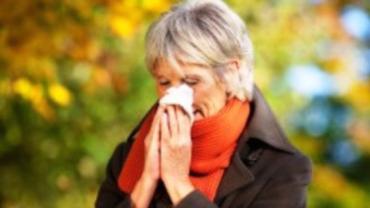
As the cooler weather blows in it is not uncommon to throw open the windows to air out the home while simultaneously enjoying crisp cool nights. Unfortunately for many coexisting with nature and the fresh air only spawns misery in the form of sneezing congestion itchy and watery eyes. Just like spring all over again.
The warm summer months serve as a prime growing season for various weeds which in full maturity utilize the cool and breezy fall weather to shed and spread their pollen. Ragweed pollen is among the most common culprits for triggering fall allergies. Releasing pollen from August to November ragweed is native to a vast majority of American soil making it virtually impossible to escape.
Similarly as the fall season progresses piles of damp leaves and morning dew provide a perfect breeding ground for mold to flourish and release allergenic spores. Mold may not only assault allergy sufferers from outdoors but can be equally troublesome indoors when the furnace is turned on for the first time releasing a mass of mold spores that have been hiding among the dirty crevices of the furnace ducts.
To fight the battle against fall allergies quercetin should be a top consideration since its history as an effective anti-allergy anti-histamine and anti-inflammatory agent is well documented. This prevalent bioflavonoid is found in apples onions grapefruit red wine and black and green teas. Its role in preventing histamine release from mast cells is multifaceted. Quercetin has been shown to suppress expression of histamine H1 receptor and inhibit mast cell secretion and NF-kappa B activation as well as inflammatory leukotrienes IL-8 tumor necrosis factor (TNF) and IL-6. Quercetin was also shown in vitro to suppress eosinophil activation which is responsible for the allergic rhinitis accompanying fall allergies. In individuals susceptible to allergic asthma quercetin is an effective bronchodilator. Not only is quercetin useful during an allergy attack but more importantly it has been shown to function prophylactically making it an essential agent to have on hand before the weather turns cooler.
Mold allergies seem to be a bit more complicated. In apparently healthy individuals seasonal mold spores may not be any more bothersome than weed pollen causing allergic rhinitis sneezing itchy and watery eyes. However in immune compromised individuals or those susceptible to lung infections or asthma mold exposure can lead to labored breathing wheezing and the feeling of a tight chest.
Aspergillus fumigatus is the most frequently encountered fungus both in the home and outdoors. The airway epithelial cells act as the fist line of defense explaining why their health is so important in determining an individual’s reaction to mold spores. Recent studies are finding that active vitamin D status is important for moderating a possible inflammatory reaction to mold spores. Upon encountering spores the airway epithelial cells activate vitamin D receptors. Vitamin D can inhibit pro-inflammatory cytokines NF-kappa B-linked chemokines and cytokines within the respiratory epithelial cells. Unfortunately vitamin D deficiencies are notorious among individuals leaving them susceptible to the seasonal effects of mold spores. Ensuring optimal vitamin D levels prior to the fall season is advantageous while continuing to provide respiratory epithelial cells with an active form of this anti-inflammatory vitamin is crucial during the fall allergy season.
Quercetin and vitamin D directly moderate the effects of allergies; however it is important to remember synergistic nutrients that will also ameliorate inflammatory reactions and thereby provide aid in the battle against fall allergies. High quality omega-3 oils can provide balance among eicosanoid derivatives and lower inflammatory reactions to allergens. Stinging nettle (Urtica dioica) is a well-documented anti-inflammatory botanical often employed for relief of allergic rhinitis. Vitamin C functions synergistically with bioflavonoids such as quercetin to not only enhance the modulation of inflammatory factors but to also aid in repairing oxidative damage resulting from allergen exposure. The foundation of an allergic reaction is inflammation and therefore intervention should be multi-tiered to include various agents that work to enhance resilience while obliterating inflammatory pathways.